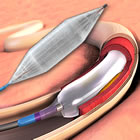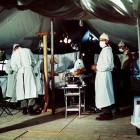
Frank J. Criado, MD
Guest Post by Frank J. Criado, MD, FACS, FSVM, editor in chief of Vascular Disease Management.
(Editor’s note: this article is the first in a series of guest posts, a new collaboration between Angioplasty.Org and Vascular Disease Management.)
In the introductory remarks of “Meta-Analysis of Outcomes of Endovascular Treatment of Infrapopliteal Occlusive Disease With Drug-Eluting Stents,” lead author George A. Antoniou and his colleagues, from the Manchester Royal Infirmary in the UK, state that:
“Emerging evidence suggests that the combination of stenting and targeted delivery of drugs with antiproliferative properties, aiming to inhibit smooth muscle cell proliferation and intimal hyperplasia, improves the outcomes of endoluminal treatments of distal vessel disease. A small number of series have demonstrated satisfactory performance of drug-eluting stents, as expressed by increased patency and freedom from revascularisation to maintain good clinical results. Controversy exists, however, with regard to the superiority of drug-eluting stents over bare metal stents in terms of the clinical benefit in critical limb ischaemia patients.” Continue reading →




 Today is Veterans Day in the U.S., honoring the soldiers who fought in the country’s wars. Last week was the VIVA 14 meeting, presenting the latest advances and techniques in endovascular repair and therapy of blood vessels.
Today is Veterans Day in the U.S., honoring the soldiers who fought in the country’s wars. Last week was the VIVA 14 meeting, presenting the latest advances and techniques in endovascular repair and therapy of blood vessels.


